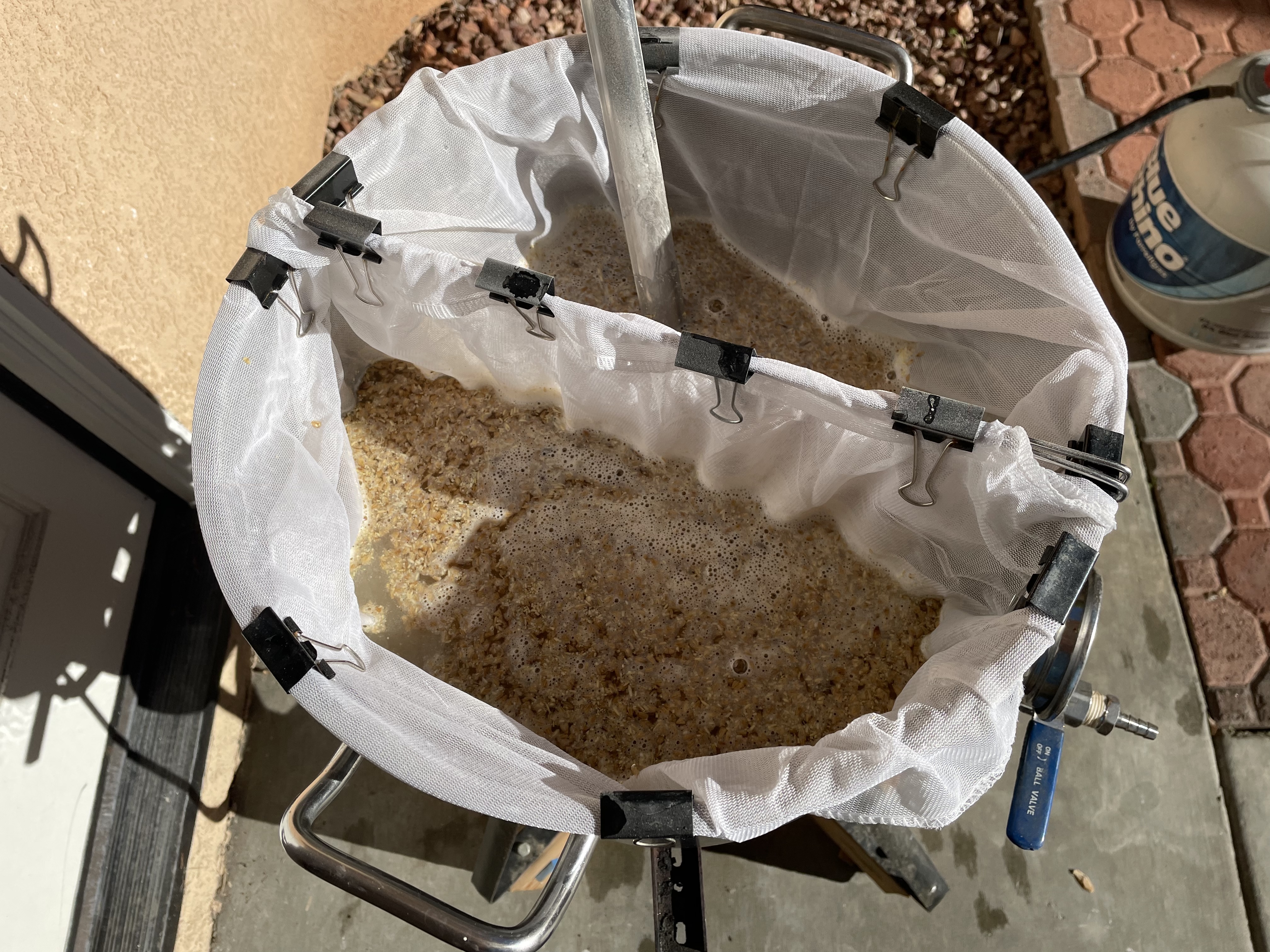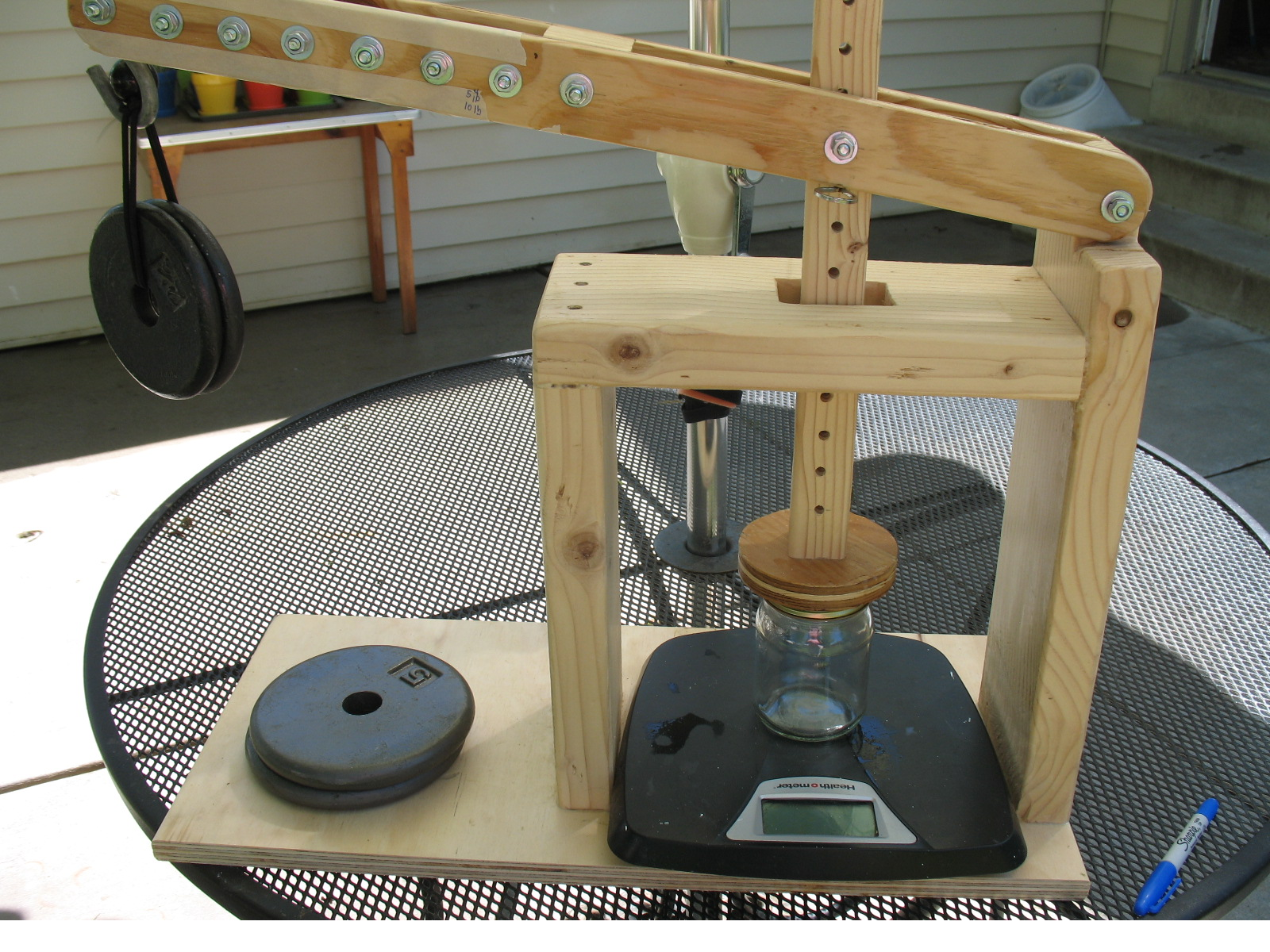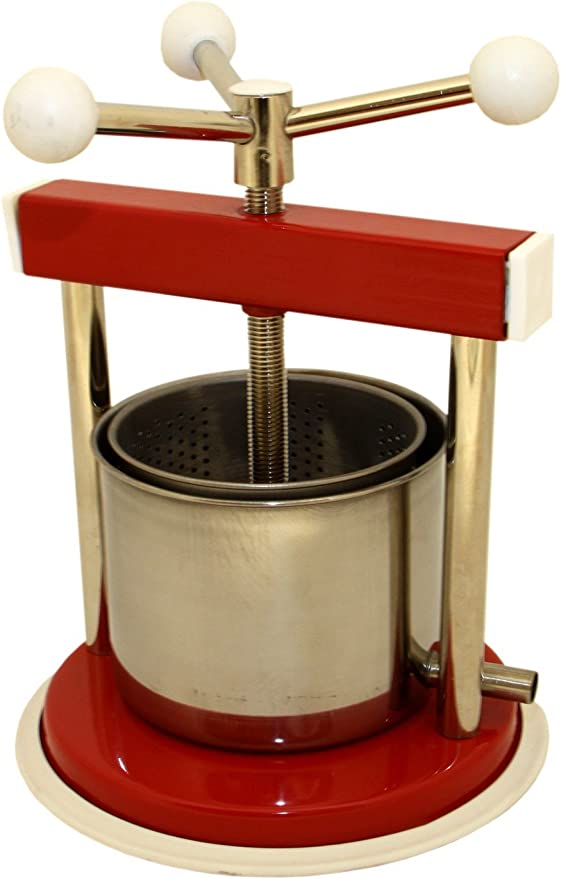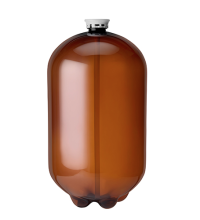I use a ratchet pulley with a step ladder to lift. Then I squezze using insulated rubber gloves. I also use a large stainless colander with the rubber gloves when doing stovetop batches.
You are using an out of date browser. It may not display this or other websites correctly.
You should upgrade or use an alternative browser.
You should upgrade or use an alternative browser.
What do you use when you squeeze BIAB?
- Thread starter Shawn3997
- Start date

Help Support Homebrew Talk:
This site may earn a commission from merchant affiliate
links, including eBay, Amazon, and others.
I use the storage bin for my equipment with an inverted stainless bowl and a cookie sheet angled down from the bowl inside the bin. I put the bag at the top of the cookie sheet and use a pot lid to press down. The wort collects in the bin and I then pour it all back into the pot. The wort isn't so hot that I need gloves at this point but it is too hot to use my hands to squeeze. I get great efficiency this way.
I'm only on BIAB batch #4; today I let the bag drain out for about 10 minutes, then lowered it onto an oven rack on my BK. Then I used the lid from my kettle to squish the heck out of the bag. With 10g strike on a 13lb grain bill, I netted 9 gallons of wort. Once the bag is squished I use the pulley to lift it just high enough so I can swing it over into a waiting homer bucket to cool before dumping out. Letting the bag drain out for 10 minutes really minimized the spillover I've gotten the last few brews.
I hoist the bag above the kettle, then I use a ~3' length of rope which I loop around the bag and pull the ends apart to squeeze out the goodness. I do this several times at various positions on the bag to get as much liquid out as possible. Great workout for the chest muscles and tunes up my skills with a garrote just in case.
- Joined
- Mar 4, 2013
- Messages
- 47
- Reaction score
- 5
After trying various methods, now I hoist the bag and let it gradually drain while I kick off the boil. Once the drain has slowed to a drip I'll hold the top and give the lower end a spin to wring out a bit more. Never had an astringency issue, at least thus far.

$58.16
HUIZHUGS Brewing Equipment Keg Ball Lock Faucet 30cm Reinforced Silicone Hose Secondary Fermentation Homebrew Kegging Brewing Equipment
xiangshuizhenzhanglingfengshop

$53.24
1pc Hose Barb/MFL 1.5" Tri Clamp to Ball Lock Post Liquid Gas Homebrew Kegging Fermentation Parts Brewer Hardware SUS304(Gas MFL)
Guangshui Weilu You Trading Co., Ltd
![Craft A Brew - Safale S-04 Dry Yeast - Fermentis - English Ale Dry Yeast - For English and American Ales and Hard Apple Ciders - Ingredients for Home Brewing - Beer Making Supplies - [1 Pack]](https://m.media-amazon.com/images/I/41fVGNh6JfL._SL500_.jpg)
$6.95 ($17.38 / Ounce)
$7.47 ($18.68 / Ounce)
Craft A Brew - Safale S-04 Dry Yeast - Fermentis - English Ale Dry Yeast - For English and American Ales and Hard Apple Ciders - Ingredients for Home Brewing - Beer Making Supplies - [1 Pack]
Hobby Homebrew

$53.24
1pc Hose Barb/MFL 1.5" Tri Clamp to Ball Lock Post Liquid Gas Homebrew Kegging Fermentation Parts Brewer Hardware SUS304(Liquid Hose Barb)
yunchengshiyanhuqucuichendianzishangwuyouxiangongsi

$20.94
$29.99
The Brew Your Own Big Book of Clone Recipes: Featuring 300 Homebrew Recipes from Your Favorite Breweries
Amazon.com

$49.95 ($0.08 / Fl Oz)
$52.99 ($0.08 / Fl Oz)
Brewer's Best - 1073 - Home Brew Beer Ingredient Kit (5 gallon), (Blueberry Honey Ale) Golden
Amazon.com

$479.00
$559.00
EdgeStar KC1000SS Craft Brew Kegerator for 1/6 Barrel and Cornelius Kegs
Amazon.com

$22.00 ($623.23 / Ounce)
AMZLMPKNTW Ball Lock Sample Faucet 30cm Reinforced Silicone Hose Secondary Fermentation Homebrew Kegging joyful
无为中南商贸有限公司

$719.00
$799.00
EdgeStar KC2000TWIN Full Size Dual Tap Kegerator & Draft Beer Dispenser - Black
Amazon.com

$33.99 ($17.00 / Count)
$41.99 ($21.00 / Count)
2 Pack 1 Gallon Large Fermentation Jars with 3 Airlocks and 2 SCREW Lids(100% Airtight Heavy Duty Lid w Silicone) - Wide Mouth Glass Jars w Scale Mark - Pickle Jars for Sauerkraut, Sourdough Starter
Qianfenie Direct

$176.97
1pc Commercial Keg Manifold 2" Tri Clamp,Ball Lock Tapping Head,Pressure Gauge/Adjustable PRV for Kegging,Fermentation Control
hanhanbaihuoxiaoshoudian

$44.99
$49.95
Craft A Brew - Mead Making Kit – Reusable Make Your Own Mead Kit – Yields 1 Gallon of Mead
Craft a Brew

$76.92 ($2,179.04 / Ounce)
Brewing accessories 1.5" Tri Clamp to Ball Lock Post Liquid Gas Homebrew Kegging Fermentation Parts Brewer Hardware SUS304 Brewing accessories(Gas Hose Barb)
chuhanhandianzishangwu

$7.79 ($7.79 / Count)
Craft A Brew - LalBrew Voss™ - Kveik Ale Yeast - For Craft Lagers - Ingredients for Home Brewing - Beer Making Supplies - (1 Pack)
Craft a Brew
my bag hangs over the kettle while I'm heating to boil. After a while I will give it a few squeezes with my hands
ouch...
Whatever rocks your world, friend...
why yes, I am 12yrs old at heart ... why do you ask?


Last edited:
I squeeze like that but I should incorporate the twist!Silicon pot holders and my man-hands
I kind of milk it like a giant beer-filled cow after twisting it a bit.
I used to squeeze the bag as soon as I removed it from the kettle, but I've stopped. I usually let it drain for 10 min or so, then squeeze. Toss the grain in the woods.
Alan Reginato
Well-Known Member
I lift the bag and sparge with 1 L/Kg of malt, with room temperature water. I add this step just to get grains cold enough to hand squeeze. Asides, I add the FWH hops. Works for me.
I would love to see a pic of that setup. I was thinking of trying to do something like that in my backyard.I string up my strainer basket with my brain bag in it over the brewpot using a carribeaner and rope, hung from a ladder. I press down on the bag to squeeze with a cake pan until it's dry. It works great, but pressing on the grain bag forces it through the dime sized holes in the strainer basket which is starting to damage my grain bag.
Next time I'll skip the strainer basket and jut hang the grain bag. Not worth buying another grain bag every couple of cooks.
I think it's a variation on the Alton Brown turkey derrick:I would love to see a pic of that setup. I was thinking of trying to do something like that in my backyard.
https://altonbrown.com/how-to-build-a-turkey-derrick/
Fantastic. thanks. another diy project in the wings. LOL
I have an electric winch in my brew room and all I do is pull BIAB bag after the mash is complete and let it drip while the kettle comes up to the boil. I do not squeeze and have no noticable effect on efficiency, Same reason I do not do mash outs
Isn't the title of this forum "What do you use when you squeeze BIAB" ? Did you mean to post here? Squeeze the bagI have an electric winch in my brew room and all I do is pull BIAB bag after the mash is complete and let it drip while the kettle comes up to the boil. I do not squeeze and have no noticable effect on efficiency, Same reason I do not do mash outs
The hanging bag alone provides some squeezing force to the grain mass. Just by hanging alone, and letting drain for a long time, you can get a grain absorption rate that is about 2/3 what is typical when draining a mash tun.Isn't the title of this forum "What do you use when you squeeze BIAB" ? Did you mean to post here? Squeeze the bag
Brew on

I squeeze the bag, always have and always will.
Its free beer, I don't understand why anyone wouldn't.
Its free beer, I don't understand why anyone wouldn't.
Last edited:
I bolted together a few lengths of wood and used a simple pulley system.
As for "the squeeze" I use these gloves and follow the Brewbag example i.e. squeeze every drop out
https://www.brewinabag.com/products/pvc-gloves-rough-finish-12
As for "the squeeze" I use these gloves and follow the Brewbag example i.e. squeeze every drop out
https://www.brewinabag.com/products/pvc-gloves-rough-finish-12
Attachments
I use two bags when mashing. Usually I squeeze the bags over a metal colander. Using two bags makes the handling size much smaller and easy to do without having to set up a winch.


AmIBrewingThisRight
Member
I have a pulley system hanging from my garage ceiling. Once I pull the bag out I use two kettle lids to squeeze it (like I am playing the cymbals). I only do this if I think it's necessary, otherwise I just let it drain
- Joined
- Dec 19, 2015
- Messages
- 278
- Reaction score
- 115
I do the three buckets as well. My complete method is:A three bucket system: one bucket has holes drilled in the bottom, the other two are fully intact. The drilled bucket goes inside another bucket while the bag goes in the drilled bucket. The space in the lower bucket isn't enough to hold all of the runoff and pourover sparge water, so the drilled bucket gets switched back and forth as necessary. The actual squeezing part, I vary my technique - sometimes twist and squeeze by hand, sometimes with some kind of object, once or twice I've actually put the idle bucket on top of the bag and sat on it to press out the wort. The downside with the three bucket system is that a lot of the squeezed wort ends up coming out of the top of the bag and then draining right back into the grains, rather than going down through the holes drained in the draining bucket. The upside is that it's a functional system for a stovetop brewer like me who doesn't have enough headspace to hang the bag or even drain it in a colander on top of the kettle.
1. I just hold onto the bag and let it drain back into the pot for a couple minutes (good exercise, kinda like a wall-squat without the wall, as my induction burner and mash pot are on the floor);
2. then I dunk-sparge in a large pot;
3. then I hoist the bag up, stick a colander underneath, and let it drip back into the pot;
4. then I use the three buckets to get the last half gallon or so outa the grain bag: drilled bucket goes inside an intact bucket, grain bag goes in the drilled bucket, other intact bucket on top of that and I STAND in it and squish that s**t out of it! (Another brewer on this forum once said: "Squeeze it like it owes you money - it does!")
My $0.02
Protos
Die Schwarzbier Polizei
Many times, exhausted by hard squeezing my Bag, I was thinking that this device, scaled up to human-size proportions, would be of a great help for the task:


You could spank the monkey and squeeze your bag at the same time....
... what?

... what?

Protos
Die Schwarzbier Polizei
You could spank the monkey and squeeze your bag

- Joined
- Dec 19, 2015
- Messages
- 278
- Reaction score
- 115
"Exhausted by hard squeezing my bag" 


OK who is going to report this thread...
OK who is going to report this thread...
FlabbyRoach
Well-Known Member
- Joined
- Jul 5, 2013
- Messages
- 71
- Reaction score
- 21
I’m with you wilser. I pull it up and let it hang until I put my chiller in at 15 minutes. I bet ya I don’t even lose a cup of wort. Best $40 I spent on my set up. Thank you sir!!!Depends how strong you are
I recall reading of a basket failure where the wire handle spread while hoisting a large grain bill.
Am I one of lazy few that just prefers to let the bag drain for 20 -30 minutes and give it a light squeeze to get the last half pint?
Gravity works well and is free....try it, you may be pleasantly surprised.
"I squeeze the bag, always have and always will.
Its free beer, I don't understand why anyone wouldn't."
Because I don't lose much wort at all. In another thread I asked brewers to report their accurately measured grain absorption ratios. Granted, not a large sample and what is "accurately measured"?* The anecdotal data showed squeezing to be fairly comparable to a free-hanging** bag.
*I measure wort height to the nearest mm and with the formula for a cylinder get a volume to the hundredth of a gallon, ~1.7oz.
**As @doug293cz mentions above, a free hanging bag provides its own squeeze.
In the end, squeeze or don't squeeze. Make it consistent. With a free-hanging bag and ~20m per running, I get a very consistent ~.0875 gal/lb absorption rate.
Its free beer, I don't understand why anyone wouldn't."
Because I don't lose much wort at all. In another thread I asked brewers to report their accurately measured grain absorption ratios. Granted, not a large sample and what is "accurately measured"?* The anecdotal data showed squeezing to be fairly comparable to a free-hanging** bag.
*I measure wort height to the nearest mm and with the formula for a cylinder get a volume to the hundredth of a gallon, ~1.7oz.
**As @doug293cz mentions above, a free hanging bag provides its own squeeze.
In the end, squeeze or don't squeeze. Make it consistent. With a free-hanging bag and ~20m per running, I get a very consistent ~.0875 gal/lb absorption rate.
Last edited:
crazyjake19
Well-Known Member
I lift the bag and set it in a large colander over the brewpot while it ramps up to a boil. After the dripping stops, I've give it a few good squeezes with some silicone BBQ gloves.
I found something nice for applying pressure to the bag and squeeze out some more wort.
I had a bunch of those wire panels (approx 12"x12") that are used to click together and make storage cubes. I took two of the panels.. and zip tied them together along one edge. It makes a hinged "V" device that can be placed around the bag, and when pulling the front edges together, applies some nice pressure on the bag. I used a bar clamp to pull the front edges in to apply the pressure.
I had a bunch of those wire panels (approx 12"x12") that are used to click together and make storage cubes. I took two of the panels.. and zip tied them together along one edge. It makes a hinged "V" device that can be placed around the bag, and when pulling the front edges together, applies some nice pressure on the bag. I used a bar clamp to pull the front edges in to apply the pressure.
spittybug
Well-Known Member
I'm a 3 vessel HERMS setup using Sanke kegs. We are always brewing 10 gallon batches and often have ~30lbs of grain in the mash. I use one of Wilser's bags to keep the grains from flowing around the system. Recently the bag seems to be less permeable than previously and is holding the wort and drying up the circulation through the HERMS, requiring constant attention and thinning the mash. Draining consists of hoisting the bag by ratchet winch and squeezing with silicone gloves on. It's getting harder to do with age! I wonder if the bag mesh is getting more clogged with protein build up or something? After this last brew I soaked it in Oxyclean and a whole bunch of rinsing to make sure it is clean. Hopefully that will help. If not, I may have to find something that would 'eat' any residue.
I still have the idea of making a grape press style of bag squeezer since a LOT of wort gets stuck in there. Some kind of threaded rod that pushes a disc down into the mash tun. The challenge is how to mount the top of the press. My Sanke mash tun is upside down so that I drain out of the neck. That means the handles are on the bottom not the top. That would have provided a great place to slide a bar through and across the top. I do have a continuous lip around the opening, so maybe I can make something to hook under that and provide the bracing needed for a screw to be drilled downwards to compress the grains...... I need to think more.
I still have the idea of making a grape press style of bag squeezer since a LOT of wort gets stuck in there. Some kind of threaded rod that pushes a disc down into the mash tun. The challenge is how to mount the top of the press. My Sanke mash tun is upside down so that I drain out of the neck. That means the handles are on the bottom not the top. That would have provided a great place to slide a bar through and across the top. I do have a continuous lip around the opening, so maybe I can make something to hook under that and provide the bracing needed for a screw to be drilled downwards to compress the grains...... I need to think more.
I still have the idea of making a grape press style of bag squeezer since a LOT of wort gets stuck in there. Some kind of threaded rod that pushes a disc down into the mash tun. The challenge is how to mount the top of the press. My Sanke mash tun is upside down so that I drain out of the neck. That means the handles are on the bottom not the top. That would have provided a great place to slide a bar through and across the top. I do have a continuous lip around the opening, so maybe I can make something to hook under that and provide the bracing needed for a screw to be drilled downwards to compress the grains...... I need to think more.
I am wondering if a cheap inflatable bag or even a heavy duty small swimming pool float device etc. could be used to apply pressure. Sliding a cylinder over the bag with the deflated pillow on one side.. Then pumping the pillow to squeeze on the bag. Offhand I think it is intriguing. It would be a broad spread pressure. It certainly would be a simple rig, and it would be light enough to suspend easily with the bag. I guess more than one bag could be used as well.
The rub is to find a strong bag that is hose-connectable that doesn't cost much.
A quick search for 'inflatable bag' shows many nylon wrapped bags that I would think would be plenty strong. - Camping air bag?
Lift bags get professional and costly real quick.. but evidently there is a scuba application that could be a nice compromise
https://www.amazon.com/JRangelp-Adj..._32?keywords=Lift+Bags&qid=1669064774&sr=8-32
or maybe even an ATV or lawn tractor inner-tube hmmm...
spittybug
Well-Known Member
I'm liking the idea. Ideally something with an easy hand pump or even a compressor line. Slipping it between the bag and the side wall of the keggle should work to squish it against the far wall if the expansion of the bag is big enough. The other issue is preventing the contents from coming out of the top of the bag, but that should be easy enough to prevent by wrapping its cord around it several times. I wouldn't have a qualm trying this with a good strong keg shell, but a thinner walled pot would probably deform. I too shall start looking for suitable air bags as well as continuing on my screw idea.I am wondering if a cheap inflatable bag or even a heavy duty small swimming pool float device etc. could be used to apply pressure. Sliding a cylinder over the bag with the deflated pillow on one side.. Then pumping the pillow to squeeze on the bag. Offhand I think it is intriguing. It would be a broad spread pressure. It certainly would be a simple rig, and it would be light enough to suspend easily with the bag. I guess more than one bag could be used as well.

If you use something as a vessel that doesn't have to be kept pristine, then the option of having something flimsy, that will deform under pressure comes into play. As long as it has sufficient tensile strength to keep from coming apart it could be used. I thought about testing with a 5 gal bucket and cutting the top and bottom off leaving a plastic cylinder. If you could get ahold of one of those PET plastic keg vessels I see in brewing videos, that would be ideal.. super light.. extremely strong.I wouldn't have a qualm trying this with a good strong keg shell, but a thinner walled pot would probably deform. I too shall start looking for suitable air bags as well as continuing on my screw idea.
Attachments
spittybug
Well-Known Member
I'm having a difficult time finding something that would expand sufficiently. The best I've come up with is a small diameter inner tube. Messy...... between having to slide it over the bag, then air it up, it still would only squeeze ~6" or so of the bag, resulting in a dumbbell effect. I'm not sure rubber would add much of a good flavor either.
I'm still thinking that a big screw (like for a bench vise) with a plate on the bottom is a good approach. The throw wouldn't have to be more than a few inches if there were a way to wedge it against the side of the keggle and be able to release it, move it down a bit and then re wedge it (instead of a fixed setup as shown below). Alternatively, something like a Dutch cheese press lever could work. Mount a long arm to the top rim of the keggle and hinge a down rod a foot or two away from the mounting point. Pulling down on the long arm would provide a lot of leverage to force the down rod (and its foot) into the tied up grain bag.
I'm leaning towards the Dutch press design since the down rod can be made adjustable and mounting a simple hinge on top of the keggle wouldn't be hard. The rest is just wood or stainless steel (maybe Sanke spears?).


I'm still thinking that a big screw (like for a bench vise) with a plate on the bottom is a good approach. The throw wouldn't have to be more than a few inches if there were a way to wedge it against the side of the keggle and be able to release it, move it down a bit and then re wedge it (instead of a fixed setup as shown below). Alternatively, something like a Dutch cheese press lever could work. Mount a long arm to the top rim of the keggle and hinge a down rod a foot or two away from the mounting point. Pulling down on the long arm would provide a lot of leverage to force the down rod (and its foot) into the tied up grain bag.
I'm leaning towards the Dutch press design since the down rod can be made adjustable and mounting a simple hinge on top of the keggle wouldn't be hard. The rest is just wood or stainless steel (maybe Sanke spears?).


Another thought - You could place a plate on each side of the bag and use a handscrew clamp to put the squeeze on it. They can get pretty big.. Harbor Freight has a 12" one for $12.
Or maybe even buy the mechanical components of one of those clamps and use a couple of 2x4's to make an extra wide version Wooden Hand Screw Clamp Kits with Rods, Pivot Nuts and Handles (DCE)10" I guess you could rob the mechanical components of the harbor freight clamp.
Or maybe even buy the mechanical components of one of those clamps and use a couple of 2x4's to make an extra wide version Wooden Hand Screw Clamp Kits with Rods, Pivot Nuts and Handles (DCE)10" I guess you could rob the mechanical components of the harbor freight clamp.
Attachments
Last edited:
FloppyKnockers
Well-Known Member
I have a mixing bowl that's larger than my kettle. I drilled a bunch of holes in the bottom turning it into more of a colander. After I hoist the bag, let it drip for a few, I put the bowl/colander on the kettle and lower the bag into it. I twist the top end of the bag gathering all the grains tight. Then I use a 2 liter measuring cup and press down on various locations on the bag. Get's the job done nicely.
The Barking Dog
Member
I mashout at 170° and use a ratchet strap to raise the bag up where it's hovering over the kettle, then let it drain for a bit while I adjust my panel to start boiling. Use gloves to squeeze the bag every few minutes until I'm almost at a boil, then pull the bag down and let it sit in the driveway until it cools. Then toss the grain.
Don't even squeeze that hard. Just enough to easily get some more volume from the grain.
Don't even squeeze that hard. Just enough to easily get some more volume from the grain.
Similar threads
- Replies
- 11
- Views
- 783













































